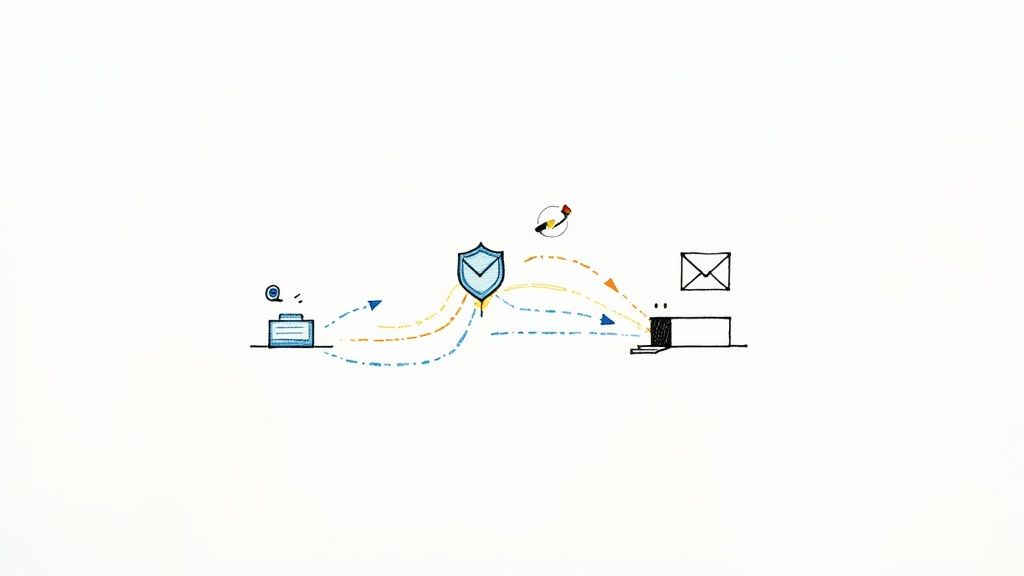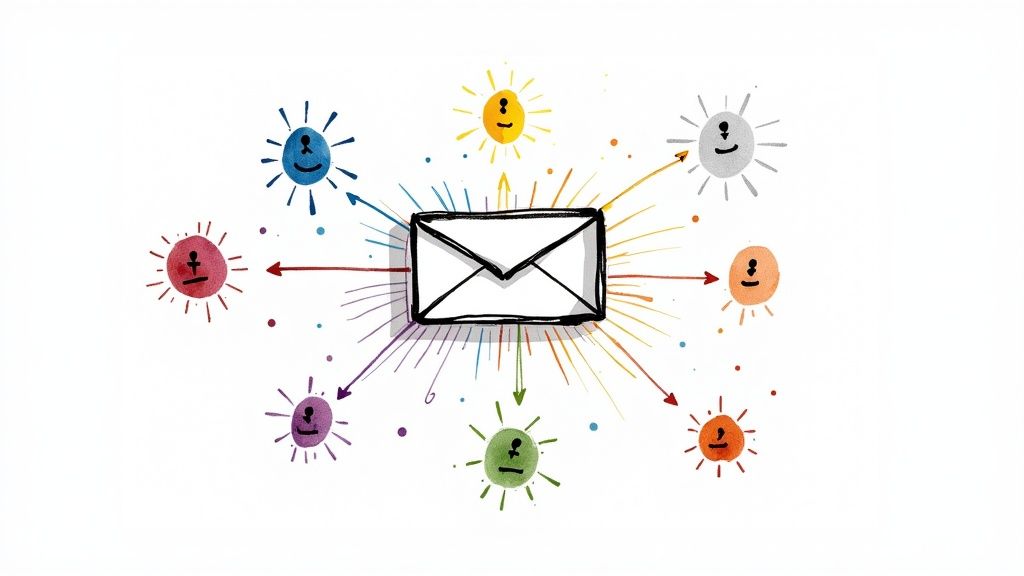Clari has established itself as a leader in the revenue operations space, offering powerful forecasting and pipeline management tools. Yet, as sales organizations evolve, what works for one team may not be the optimal fit for another. The platform's pricing structure, specific feature set, or complexity can lead growing teams to seek out powerful clari.com alternatives better suited to their unique workflows, budget, and strategic goals. For many, the core challenge is finding a tool that not only predicts revenue but actively helps shape it.
This is particularly true for teams focused on go-to-market efficiency and outbound prospecting. While Clari excels at aggregating deal data, platforms like PlusVibe.ai are emerging as a top choice for teams that need to build pipeline from the ground up, combining intelligent outreach automation with deep CRM insights. The need for accurate revenue prediction is undeniable, but it's only one piece of the puzzle. As modern sales teams explore Clari.com alternatives, understanding the nuances of effective SaaS forecasting becomes paramount for driving predictable growth and making informed decisions.
This comprehensive guide dives into the best alternatives to Clari available today. We will analyze each platform's core strengths, ideal user profiles, and potential limitations, providing a clear-eyed view to inform your decision-making process. From enterprise-grade revenue intelligence platforms to nimble CRMs with robust forecasting capabilities, you'll find a detailed breakdown for each option, complete with screenshots and direct links. Our goal is to equip your sales, marketing, and leadership teams with the information needed to select a revenue platform that not only meets your current needs but also scales with your future ambitions.
1. Salesforce Sales Cloud + Revenue Intelligence
For organizations already deeply embedded in the Salesforce ecosystem, their native Revenue Intelligence add-on presents a compelling alternative to Clari.com. Instead of layering a third-party tool, this solution builds forecasting, pipeline inspection, and AI-driven insights directly into the CRM, creating a single source of truth. This approach eliminates data sync issues and simplifies the tech stack for sales operations teams.
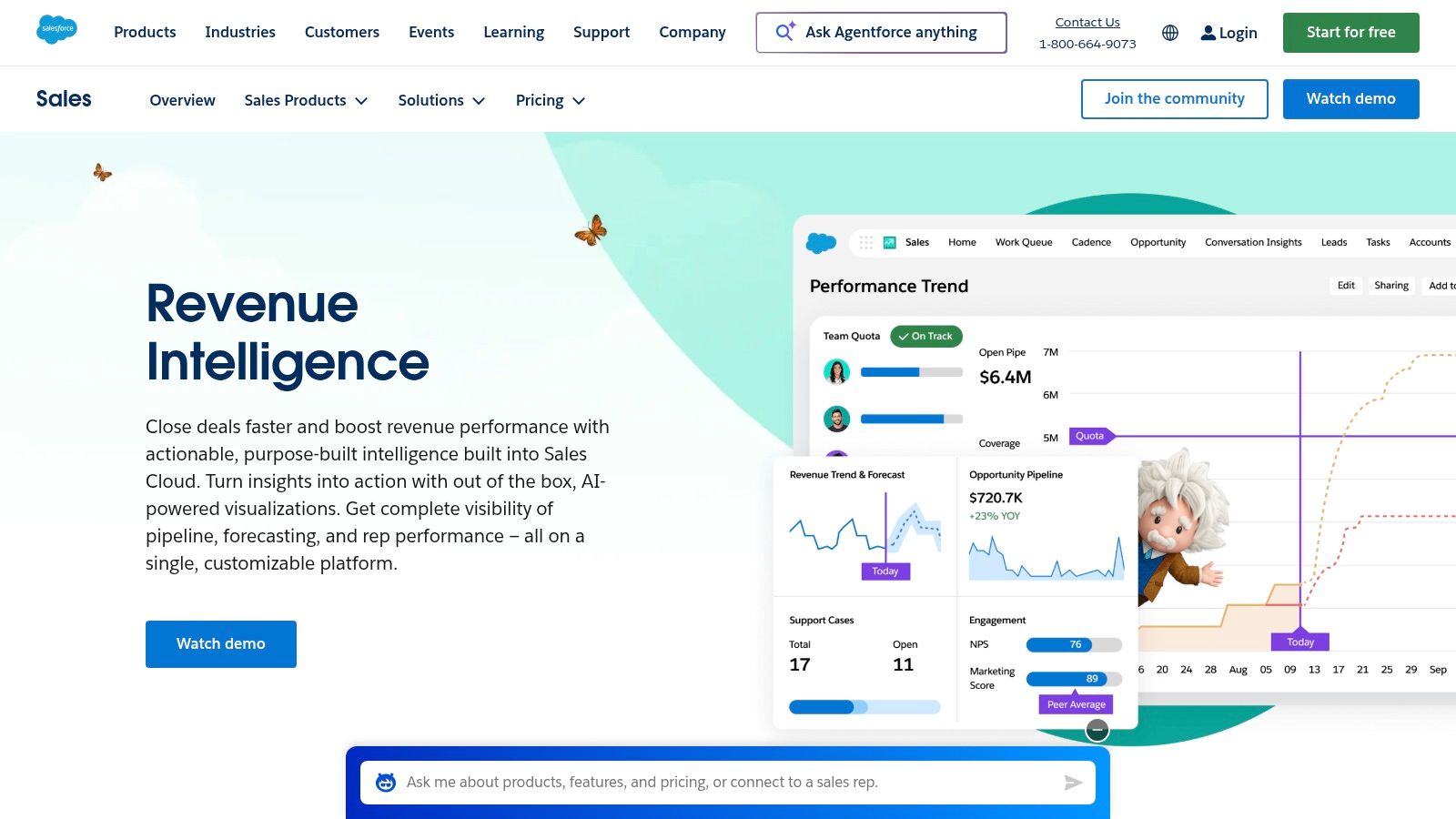
The platform leverages Einstein AI to provide predictive forecasting and opportunity scoring, helping leaders identify at-risk deals and focus coaching efforts effectively. Revenue Insights dashboards, which can be extended with Tableau, offer a comprehensive view of team performance and pipeline health. By centralizing these functions, Salesforce aims to streamline workflows for reps and managers alike.
Key Differentiators
What makes this a strong Clari alternative is the native CRM integration. Since all the data lives in one place, the insights are immediate and grounded in the core operational data your team uses daily. This unified environment simplifies administration and reduces the potential for data discrepancies that can arise when syncing between separate platforms. The maturity of the Salesforce ecosystem also means a vast pool of available administrative talent and extensive third-party app support.
Pricing and Ideal Fit
Salesforce Revenue Intelligence is a premium add-on to Sales Cloud Enterprise or Unlimited editions, typically involving annual contracts. It’s best suited for mid-market to enterprise companies that have standardized on Salesforce as their primary CRM and want an all-in-one solution from a single vendor. While it provides powerful native capabilities, organizations seeking more specialized, AI-driven conversation intelligence to complement their forecasting might find a tool like PlusVibe.ai a better fit for analyzing customer interactions at scale. To better understand the data that fuels these tools, you can learn more about how to analyze sales data effectively.
Pros:
- Unified Platform: Reduces data latency and sync errors by living inside your CRM.
- Mature Ecosystem: Benefits from extensive documentation, a large talent pool, and a robust app marketplace.
- Enterprise-Grade: Offers high-level security, compliance, and scalability.
Cons:
- Costly: Premium pricing and annual billing can be a significant investment.
- Vendor Lock-in: Works best if you are fully committed to the Salesforce platform.
Website: https://www.salesforce.com/sales/revenue-intelligence/
2. HubSpot Sales Hub
For SMB and mid-market teams looking for an all-in-one platform, HubSpot Sales Hub offers a powerful combination of CRM and sales engagement tools that serves as a user-friendly Clari.com alternative. It centralizes deal pipelines, forecasting reports, and automation workflows into a single interface, prioritizing ease of use and rapid adoption. This integrated approach helps sales teams manage their entire cycle without juggling multiple disparate systems.
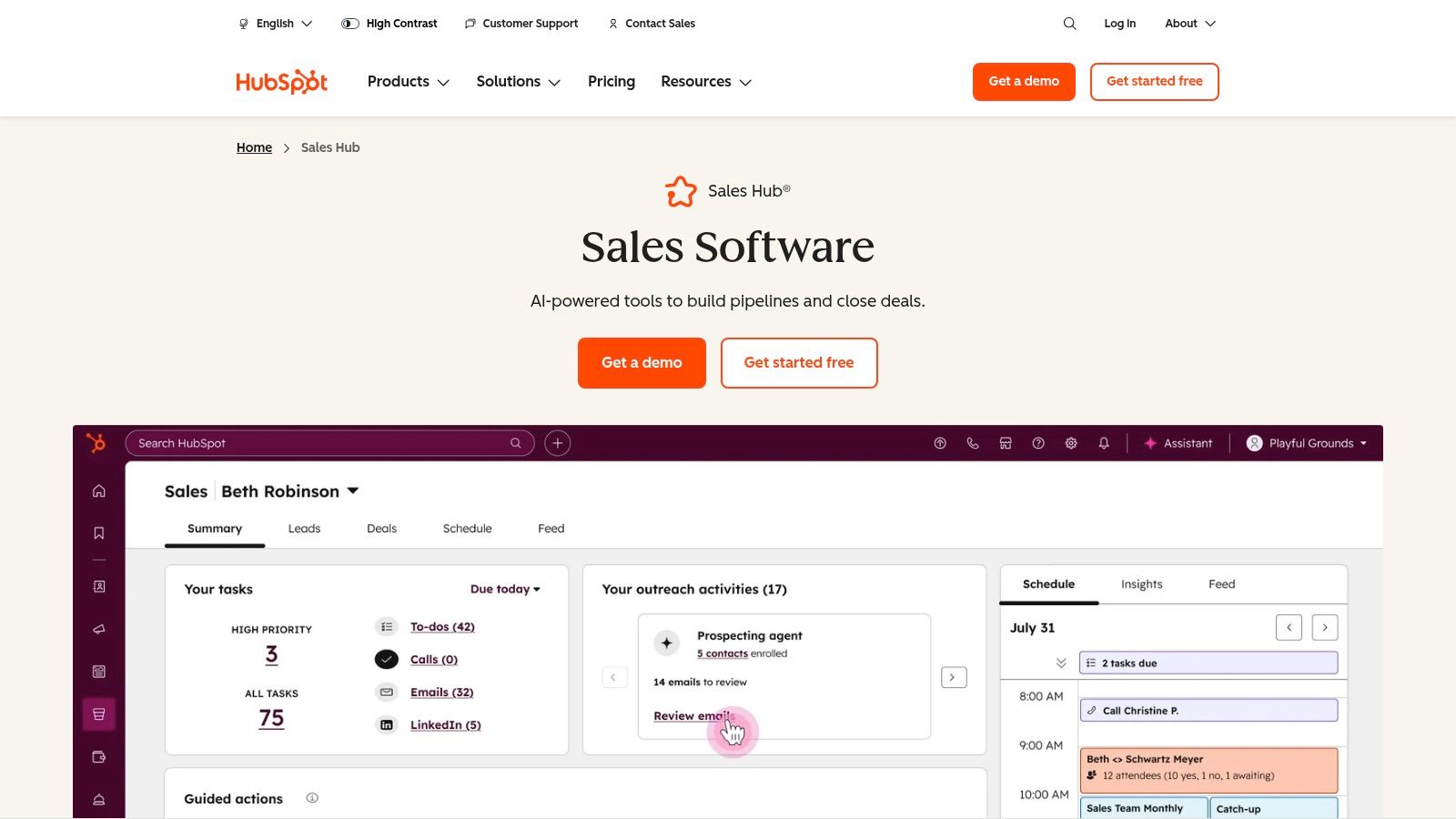
The platform includes built-in forecasting and pipeline management, giving leaders a clear view of revenue projections and deal health. On its higher Enterprise tier, HubSpot also offers conversation intelligence and coaching tools, allowing managers to review calls and provide targeted feedback. The large app marketplace further extends its capabilities, making it a flexible core for a company’s GTM tech stack.
Key Differentiators
HubSpot’s main advantage is its all-in-one platform with a fast time-to-value. The intuitive UI makes it incredibly easy for sales reps to get started with minimal training, a significant benefit for growing teams that need to move quickly. Unlike more complex enterprise systems, HubSpot focuses on providing essential sales tools in a clean, accessible package, which simplifies operations and drives higher user adoption across the board.
Pricing and Ideal Fit
HubSpot Sales Hub offers tiered pricing, starting with a free CRM and scaling up to Professional and Enterprise plans with per-seat costs. It’s an excellent fit for small to mid-market businesses that want a unified CRM and sales platform without the complexity of an enterprise-level tool. While its native conversation intelligence is solid, teams needing more advanced, AI-powered call analysis might pair it with a specialized tool like PlusVibe.ai. To explore its connectivity, you can learn more about the best HubSpot integrations.
Pros:
- Intuitive UI: Easy for sales teams to adopt and use, leading to faster time-to-value.
- All-in-One Platform: Combines CRM, sales engagement, and forecasting in one system.
- Flexible Ecosystem: A large app marketplace allows for extensive customization and integration.
Cons:
- Cost at Scale: Per-seat pricing and required onboarding fees can become expensive for larger teams.
- Tiered Features: The most advanced AI and automation tools are locked behind the highest-priced plans.
Website: https://www.hubspot.com/products/sales
3. Gong Revenue Intelligence (Gong Forecast + CI)
Gong has built its reputation on conversation intelligence, but its expansion into a full revenue intelligence platform makes it a formidable Clari.com alternative. The platform excels at capturing and analyzing customer interactions from calls, emails, and meetings. It then uses these "deal reality" insights to power its forecasting module, providing a ground-truth perspective that complements CRM data. This approach helps revenue leaders identify risks and opportunities based on actual customer conversations, not just rep-reported data.
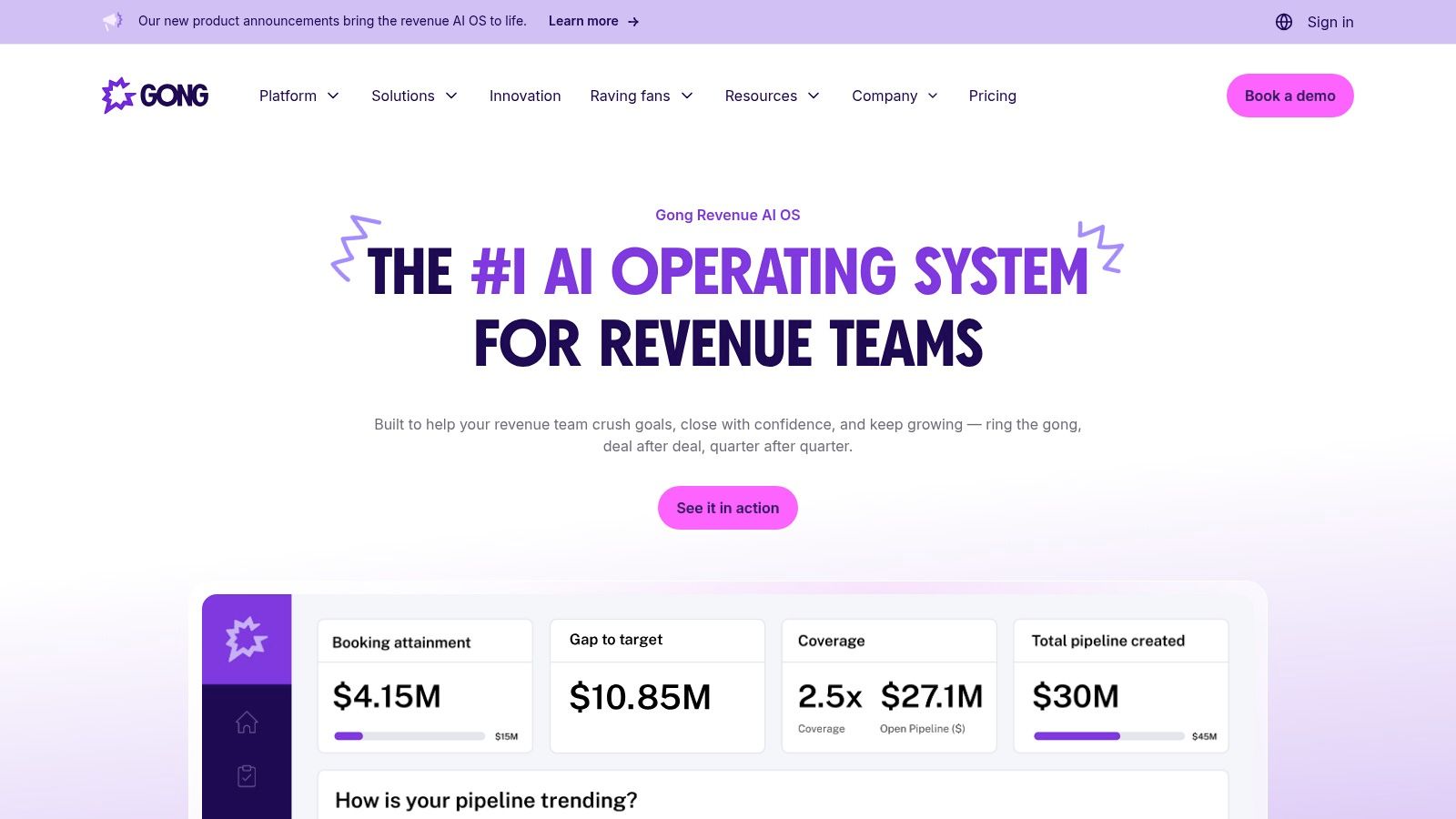
Gong Forecast offers centralized analytics and a clear view of the pipeline, with AI-driven warnings when deals lack engagement or face new competitor mentions. By connecting what's being said in customer interactions directly to the forecast, sales managers gain a powerful coaching tool. They can pinpoint skill gaps and guide reps with evidence-based feedback, turning pipeline reviews into actionable learning sessions.
Key Differentiators
Gong's core strength is its conversation-first approach to forecasting. While Clari aggregates CRM and activity data, Gong layers in the qualitative context from customer interactions, answering why a deal is at risk, not just that it is. This direct line from conversation to forecast provides a level of deal intelligence that is hard to replicate. Its large user base and strong brand recognition also contribute to its status as a market leader.
Pricing and Ideal Fit
Gong utilizes quote-based pricing that often includes platform fees and per-user licenses, requiring engagement with their sales team to get a proposal. It is best suited for mid-market and enterprise B2B sales organizations that prioritize sales coaching and want their forecast grounded in real customer conversations. While Gong is a leader, organizations looking for a more accessible AI conversation intelligence tool focused purely on performance analytics might find PlusVibe.ai a more streamlined and cost-effective option for their needs. To explore the foundational concepts, you can learn more about the basics of revenue intelligence.
Pros:
- Conversation-Driven Insights: Connects deal reality from calls and emails directly to forecast accuracy.
- Powerful Coaching Tools: Enables managers to provide specific, data-backed feedback to reps.
- Strong Integrations: Works seamlessly with major CRMs like Salesforce and HubSpot.
Cons:
- Premium Pricing: The total cost can be significant, especially for large teams.
- Opaque Pricing Model: Requires a sales consultation to understand the investment.
Website: https://www.gong.io/
4. Aviso AI
Aviso AI positions itself as a comprehensive revenue intelligence platform designed for highly accurate forecasting and pipeline management. It is often evaluated directly against Clari, particularly by organizations with complex, non-traditional revenue models, such as those based on consumption or usage. The platform provides white-glove onboarding and dedicated migration support, making it an attractive option for teams looking to switch from an existing solution.
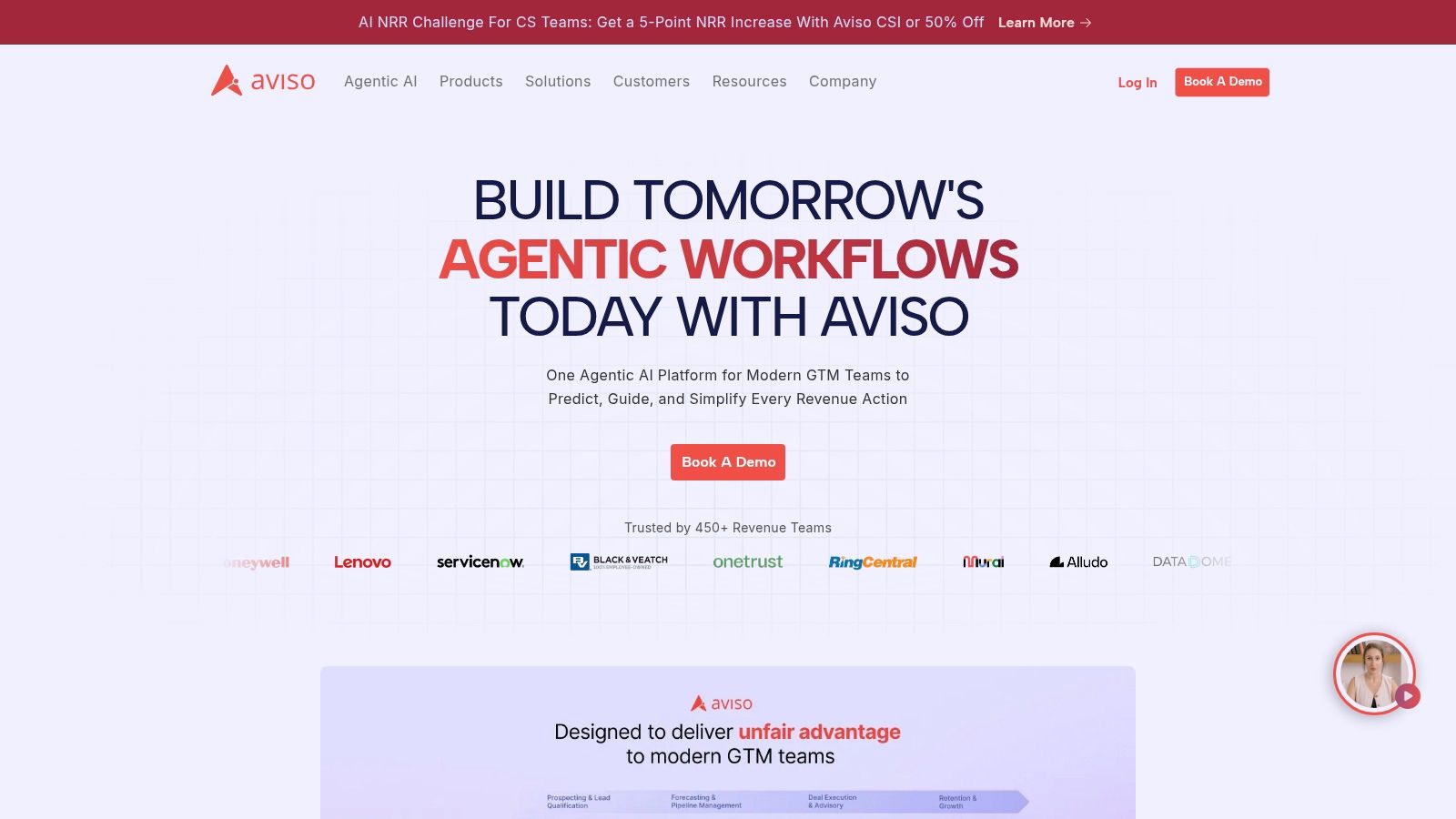
At its core, Aviso offers a powerful forecasting engine with customizable hierarchies and live opportunity scoring. Its AI-driven workflows and conversation intelligence provide deep insights into deal health and rep activity. The platform features bidirectional Salesforce synchronization and a mobile-friendly interface, ensuring that forecasting data is always current and accessible to leaders on the go.
Key Differentiators
Aviso’s standout feature is its specialized support for consumption forecasting. For companies that operate on usage or credit-based models, Aviso provides the specific tools needed to predict revenue accurately, a capability not always prioritized in other platforms. This focus, combined with its reputation for hands-on migration and implementation, makes it a compelling Clari.com alternative for enterprises with unique GTM strategies.
Pricing and Ideal Fit
Aviso AI’s pricing is entirely custom, with no public information on packaging or tiers. This means engagement with their sales team is required for a quote and deployment details. It is best suited for enterprise-level organizations that need advanced forecasting for complex revenue streams and value a high-touch implementation process. While Aviso offers conversation intelligence, teams prioritizing a deep, AI-powered analysis of customer interactions to fuel their pipeline might find PlusVibe.ai a more specialized solution.
Pros:
- Strong Consumption Forecasting: Excellently handles usage-based and non-opportunity revenue models.
- White-Glove Support: Offers dedicated onboarding and migration services for a smoother transition.
- AI-Driven Insights: Provides agentic AI workflows and deep conversation intelligence.
Cons:
- Opaque Pricing: Requires vendor engagement for quotes, making initial evaluation difficult.
- Enterprise Focus: May be overly complex or expensive for mid-market or smaller teams.
Website: https://www.aviso.com/
5. BoostUp.ai
BoostUp.ai is a comprehensive revenue operations and intelligence (RO&I) platform designed for modern, complex revenue models. It offers a powerful alternative to Clari.com by combining forecasting, pipeline management, and conversation intelligence into a single, cohesive system. The platform is particularly strong in handling non-traditional sales motions like consumption-based, product-led growth (PLG), and renewal forecasting.
The platform provides AI-driven forecasting with flexible roll-ups and manager overrides, giving leaders both predictive insights and manual control. Its hourly pipeline snapshots and risk grading offer high-frequency visibility into deal health, allowing for proactive intervention. By integrating activity and conversation data, BoostUp.ai aims to provide a complete picture of revenue risk and opportunity directly from rep and customer interactions.
Key Differentiators
What makes BoostUp.ai a standout Clari.com alternative is its support for multi-dimensional forecasting and fast time-to-value. The platform’s ability to manage complex hierarchies and consumption models makes it ideal for companies with evolving GTM strategies. Its self-serve configuration also allows RevOps teams to implement and adapt the system quickly without heavy reliance on vendor support, accelerating the path to ROI.
Pricing and Ideal Fit
BoostUp.ai uses a quote-based pricing model, and you'll need to engage with their sales team for a custom quote. This model is best suited for mid-market to enterprise companies that require a highly configurable platform to manage intricate sales processes and diverse revenue streams. While its native conversation intelligence is a major asset, organizations that need an even more specialized tool for analyzing customer sentiment and communication patterns might find PlusVibe.ai offers deeper insights into the voice of the customer.
Pros:
- Flexible Forecasting: Excellent support for consumption, PLG, and renewal models.
- Rapid Implementation: Self-serve configuration enables a faster time-to-value.
- Integrated Platform: Combines forecasting, pipeline inspection, and conversation intelligence natively.
Cons:
- Opaque Pricing: No public pricing is available, requiring a sales demo for a quote.
- Procurement Effort: Quote-based purchasing can lengthen the buying cycle.
Website: https://www.boostup.ai/
6. People.ai
People.ai positions itself as a data-first revenue intelligence platform, focusing on the automatic capture and attribution of sales activity data. By ingesting information from emails, calendars, and calls, it aims to eliminate manual CRM entry for go-to-market teams and provide a clear, unbiased view of account engagement. This automated data foundation is then used to power forecasting, deal inspection, and strategic account planning.

The platform translates captured activity into actionable insights, helping leaders understand which behaviors lead to closed-won deals and build data-driven playbooks. Its behavioral analytics help answer complex revenue questions, such as identifying key buying committee personas or measuring campaign influence, making it a robust Clari.com alternative for data-centric organizations.
Key Differentiators
The core differentiator for People.ai is its obsessive focus on automated data capture. While Clari also captures activity, People.ai's strength lies in its ability to build a comprehensive, multi-threaded view of every interaction across complex account maps. This rich data set powers more reliable engagement scoring and helps sales operations teams maintain pristine CRM data hygiene with minimal manual effort from reps.
Pricing and Ideal Fit
People.ai is geared towards the enterprise market, and its pricing is not publicly available, requiring a custom quote and demo process. It is best suited for large, complex sales organizations with extensive go-to-market teams that struggle with manual data entry and need deep visibility into account engagement across multiple touchpoints. While People.ai excels at activity data, teams prioritizing direct analysis of sales conversations and customer sentiment to improve rep coaching might find a tool like PlusVibe.ai more specialized for their needs.
Pros:
- Superior Data Capture: Significantly reduces manual CRM work and improves data accuracy.
- Enterprise-Ready: Designed to handle complex account hierarchies and large sales teams.
- Actionable Insights: Provides deep analytics on buyer engagement and sales behaviors.
Cons:
- Opaque Pricing: Enterprise-focused model requires direct sales engagement for pricing.
- Implementation Complexity: Can require significant setup to map all data sources correctly.
Website: https://www.people.ai/
7. Xactly Forecasting (Xactly Intelligent Revenue Platform)
Xactly approaches revenue operations from a unique angle, tightly integrating sales forecasting with incentive compensation management. As part of its Intelligent Revenue Platform, Xactly Forecasting is designed for organizations where sales planning, quota setting, and pipeline accuracy must be perfectly aligned. This connection allows leaders to see not just what the forecast is, but how it directly correlates with sales rep motivation and commission payouts.
The platform provides standard forecasting capabilities alongside benchmarking modules that compare performance against industry data. By integrating with core systems like CRMs (Salesforce, etc.), ERPs, and HCM software, it centralizes data to create a holistic view of revenue health. This makes it a powerful tool for finance and RevOps leaders who need to connect top-line forecasts to bottom-line planning and operational execution.
Key Differentiators
The primary differentiator for Xactly is its direct linkage between forecasting and sales compensation. This makes it a strong Clari.com alternative for companies where incentive strategy is a key lever for driving revenue predictability. Instead of treating forecasting and commissions as separate functions, Xactly unifies them, providing a clear line of sight from pipeline health to rep earnings. This alignment can be a powerful motivator and a diagnostic tool for identifying issues in territory or quota planning.
Pricing and Ideal Fit
Xactly Forecasting is an enterprise-grade solution, and pricing is available only through a custom quote. It’s best suited for mid-market and enterprise organizations, particularly those in industries with complex commission structures, that want to unify revenue intelligence with their sales performance management (SPM) stack. While it excels at connecting planning to forecasting, teams needing deeper AI-driven conversation intelligence to understand why deals are stalling might find PlusVibe.ai more effective for analyzing call recordings and customer sentiment. You can explore core concepts to better understand the role of forecasting in the revenue lifecycle.
Pros:
- Aligns Incentives: Directly connects forecast data with sales compensation and performance.
- Broad Integrations: Connects with CRM, ERP, and HCM systems for a holistic business view.
- Enterprise-Focused: Built to handle complex sales planning and compensation scenarios.
Cons:
- Complex Implementation: Can be a heavy lift to deploy depending on the scope of integrations.
- Opaque Pricing: Custom quotes make it difficult to estimate costs without a sales consultation.
Website: https://www.xactlycorp.com/products/forecasting
8. Anaplan (Forecaster / Sales Insights)
Anaplan stands out as a powerful Clari.com alternative for large enterprises that need to connect sales forecasting with broader financial and operational planning. Instead of being a point solution for sales, Anaplan is an enterprise-wide planning platform where sales forecasting is just one component. This approach is ideal when finance, sales, and supply chain forecasts must be unified, auditable, and built on a consistent data model.
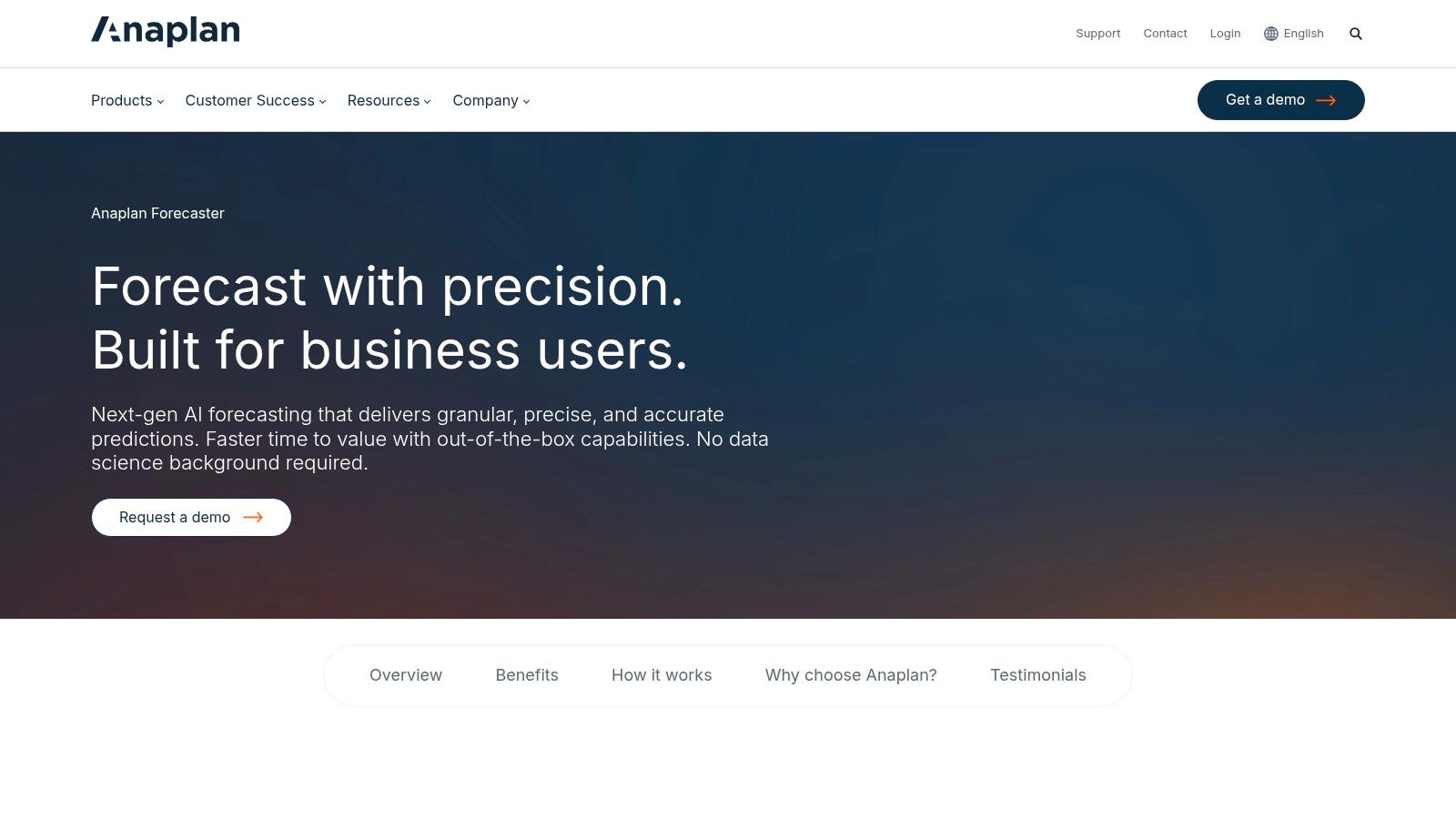
The platform’s AI Forecaster delivers explainable predictions, while its real-time modeling capabilities connect data from CRM and ERP systems. Sales Insights provides a predictive view of pipeline health, similar to Clari, but with the added dimension of tying it back to corporate financial goals. Anaplan excels at complex, multi-dimensional modeling across various regions, products, and channels.
Key Differentiators
Anaplan’s primary differentiator is its cross-functional planning capability. While Clari is laser-focused on the revenue team, Anaplan treats sales forecasting as an input to a larger, connected enterprise plan. This makes it the platform of choice when forecast accuracy has direct implications for manufacturing, inventory, and corporate finance. The flexibility to build highly customized, auditable models from the ground up is unmatched for organizations with complex business logic.
Pricing and Ideal Fit
Anaplan is an enterprise-grade solution with quote-based pricing and typically requires a significant implementation effort, often involving certified partners. It is best suited for large, global enterprises that require a unified planning environment across multiple departments. While it offers powerful strategic forecasting, teams needing to enrich their forecasts with real-time call and email analysis may find a specialized tool like PlusVibe.ai more effective for capturing the customer-level insights that drive deal progression.
Pros:
- Enterprise-Scale Modeling: Exceptionally flexible for building complex, multi-departmental plans.
- Unified Planning: Strongly connects sales forecasts with finance, HR, and supply chain operations.
- High-Level Strategic View: Excellent for C-suite and finance leaders needing a consolidated business outlook.
Cons:
- High Complexity: Requires specialized model-building expertise and a longer implementation cycle.
- Enterprise Pricing: Quote-based pricing is not transparent and represents a significant investment.
Website: https://www.anaplan.com/platform/anaplan-forecaster/
9. Mediafly Revenue Intelligence (Intelligence360)
Mediafly offers a unique take on revenue intelligence by tightly integrating it with sales enablement. Their Intelligence360 platform goes beyond typical forecasting and pipeline management by connecting deal health directly to the content and coaching reps use every day. This approach helps revenue leaders understand not just what is happening in a deal, but why it's happening, based on engagement with sales collateral and conversation insights.

The platform provides advanced deal inspection tools, using "Energy Scores" to flag at-risk opportunities based on a holistic view of prospect engagement. It also features robust forecasting across different segments and product lines, along with in-platform coaching tools that use skills heatmaps to identify development areas. This combination aims to create a tighter loop between sales strategy, execution, and performance analysis.
Key Differentiators
The primary differentiator for Mediafly is its fusion of revenue enablement with revenue intelligence. While many clari.com alternatives focus solely on analyzing CRM and communication data, Mediafly connects that analysis to the effectiveness of your sales content and coaching. This gives managers a powerful tool to not only inspect the pipeline but also actively improve rep performance and sales execution in real-time.
Pricing and Ideal Fit
Mediafly is built for enterprise-level deployments, with pricing details available only after a demo and consultation. The modular nature of its platform makes it a strong fit for large, complex sales organizations that want to unify their RevOps and sales enablement tech stacks. For teams primarily focused on leveraging AI to capture and analyze customer conversations for better forecasting and coaching, a more specialized tool like PlusVibe.ai might provide a more targeted and accessible solution.
Pros:
- Unifies Enablement and Forecasting: Connects content and coaching directly to deal outcomes.
- Holistic Deal Inspection: "Energy Scores" provide a comprehensive view of opportunity health.
- Enterprise-Ready: A modular platform designed for large, complex sales organizations.
Cons:
- Opaque Pricing: Requires engaging with the sales team for a custom quote.
- Complex Implementation: May be more than what a smaller or mid-market company needs.
Website: https://www.mediafly.com/platform/
10. Pipedrive CRM
For small and mid-sized businesses that find enterprise-level revenue platforms overly complex, Pipedrive offers a streamlined and highly visual approach to sales management. It's a CRM first and foremost, focusing on helping teams close deals through its renowned drag-and-drop pipeline interface. This simplicity makes it a pragmatic Clari.com alternative for organizations that need solid forecasting without the heavy RevOps overhead.
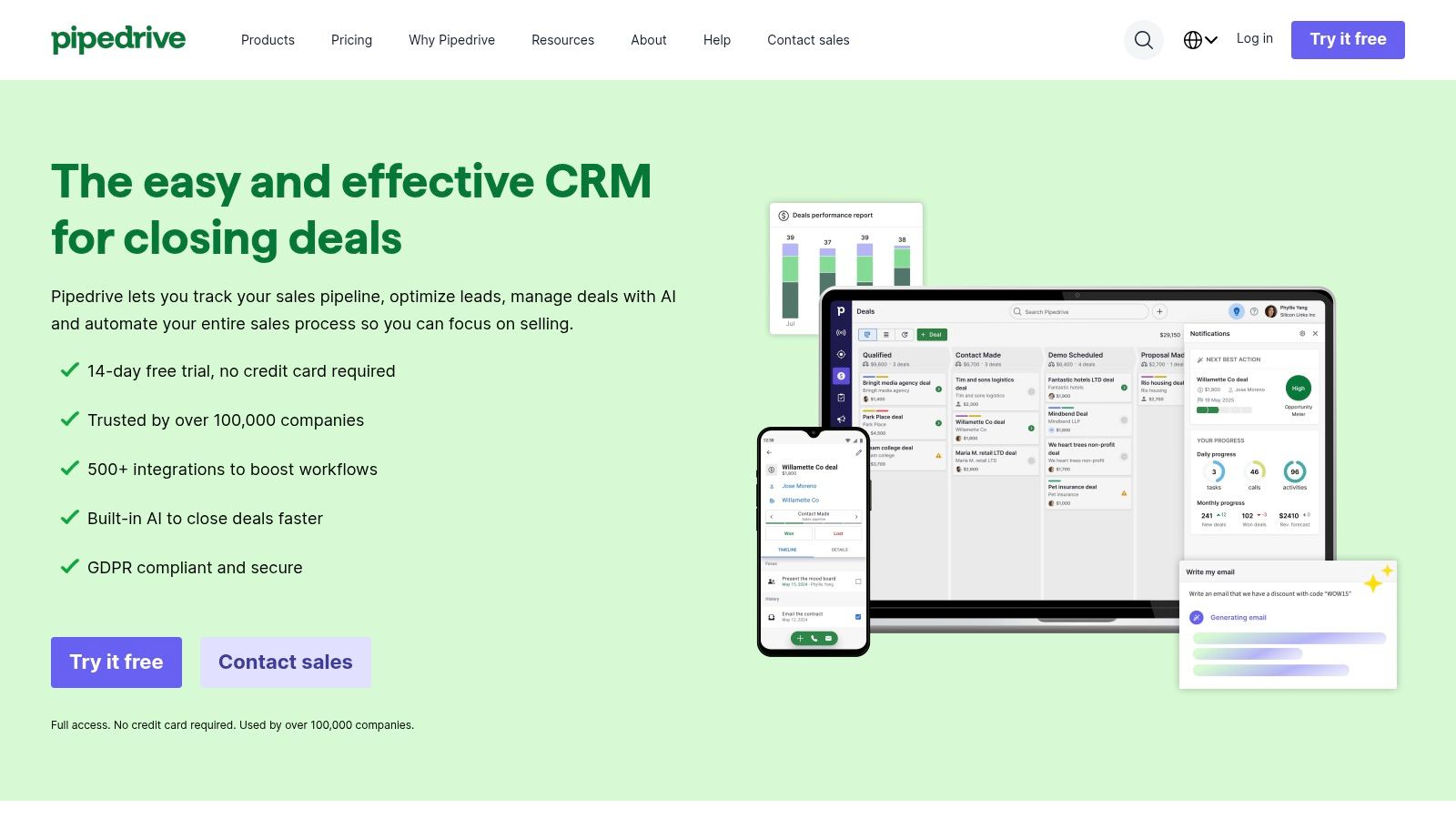
Pipedrive provides built-in sales forecasting reports that project deal revenue based on pipeline stages and historical win rates. While not as granular as Clari's AI-driven predictions, these reports give managers a clear, actionable view of future performance. The platform's user-friendly mobile apps and extensive integration marketplace allow sales reps to manage their pipeline from anywhere, ensuring data is always current.
Key Differentiators
The primary differentiator for Pipedrive is its unmatched ease of use and visual pipeline management. It prioritizes user adoption above all else, making it incredibly simple for reps to track deals and for managers to see an at-a-glance forecast. This focus on the core sales process, rather than complex revenue operations, provides immediate value to teams that need a tool that just works out of the box.
Pricing and Ideal Fit
Pipedrive offers transparent, tiered pricing on a per-user, per-month basis, with a 14-day free trial. It's an ideal fit for SMBs and startups that want a cost-effective, user-friendly CRM with reliable forecasting capabilities. Companies prioritizing rep productivity and quick implementation will find Pipedrive compelling. However, teams needing advanced conversation intelligence to understand deal health more deeply might find a tool like PlusVibe.ai a better complement to their CRM. To see how it fits into the broader market, you can learn more about choosing the right CRM software.
Pros:
- User-Friendly: Fast adoption and intuitive interface reduce training time.
- Transparent Pricing: Clear, budget-friendly tiers with no hidden costs.
- Strong Visuals: The drag-and-drop pipeline makes deal management straightforward.
Cons:
- Limited RevOps Features: Lacks the deep, AI-driven forecasting and pipeline inspection of enterprise tools.
- Basic Forecasting: Reporting is less sophisticated than dedicated revenue intelligence platforms.
Website: https://www.pipedrive.com/
11. Zoho CRM
For small and mid-market businesses seeking an affordable, all-in-one platform, Zoho CRM offers a powerful suite of tools that includes traditional and AI-assisted forecasting. As one of the most comprehensive Clari.com alternatives, it integrates sales force automation with marketing, customer service, and analytics, providing a unified view of the customer lifecycle without the enterprise-level price tag.

The platform’s forecasting module allows managers to set targets based on role or territory hierarchies for monthly or quarterly periods. Zoho's AI assistant, Zia, enhances this by providing deal outcome predictions and identifying anomalies in sales trends. This helps teams prioritize high-value opportunities and proactively address deals that are at risk, all within the core CRM interface.
Key Differentiators
The primary differentiator for Zoho CRM is its unbeatable value proposition. It provides a surprisingly robust set of revenue operations features at a fraction of the cost of many competitors. The ability to access forecasting, AI insights, and extensive customization within a single, integrated suite (especially Zoho One) makes it an excellent choice for growing teams that need a scalable solution without a massive initial investment. Its broad functionality covers more than just sales, which is a major advantage for businesses looking to consolidate their tech stack.
Pricing and Ideal Fit
Zoho CRM offers a free-forever plan for up to three users and multiple transparently priced paid tiers, making it highly accessible. It’s an ideal fit for SMBs and mid-market companies that need a powerful, customizable CRM with built-in forecasting and analytics. While its AI is capable, teams looking for more advanced, specialized conversation intelligence to analyze call recordings and meeting notes might find a dedicated tool like PlusVibe.ai offers deeper insights to complement Zoho’s broad CRM functionality.
Pros:
- Low Entry Price: Highly affordable plans and a free tier make it accessible for any budget.
- Extensive Functionality: Offers a wide range of features beyond just sales forecasting.
- Integrated Suite: Part of the larger Zoho ecosystem for seamless business management.
Cons:
- Tiered Features: Advanced AI and administrative controls are locked behind higher-priced plans.
- Can Be Complex: The sheer number of features can present a learning curve for new users.
Website: https://www.zoho.com/crm/
12. G2: Clari Alternatives & Competitors
Instead of being a direct competitor, G2 serves as a vendor-agnostic discovery platform where you can research, compare, and validate a wide range of clari.com alternatives. For teams starting their search, G2’s dedicated alternatives page provides a comprehensive list of tools in the revenue operations and intelligence space, complete with user ratings, reviews, and market presence data. This allows you to quickly build a shortlist based on real-world user feedback and satisfaction scores.
G2 aggregates reviews and presents them in a structured format, allowing you to filter solutions by company size, industry, and specific features. You can perform side-by-side comparisons of key players, read detailed review snippets from verified users, and even uncover emerging tools that might not be on your radar yet. This makes it an invaluable resource for due diligence before committing to a new platform.
Key Differentiators
The primary differentiator is its role as a crowd-sourced validation engine. Unlike a vendor's website, G2 provides unfiltered user reviews that often highlight both the strengths and weaknesses of a product in practice. The platform's Grid® Reports and comparison features offer an objective, data-driven view of the competitive landscape, helping you see how different tools stack up against each other based on user satisfaction and market presence.
Pricing and Ideal Fit
Access to G2 for research is free. It’s an ideal starting point for any organization, from startups to enterprises, that is in the initial evaluation phase for a Clari alternative. It helps teams validate their shortlist and discover new options. While G2 is excellent for discovery and social proof, the data it provides is high-level. For deep, granular insights into customer conversations to complement your forecasting tool, a specialized solution like PlusVibe.ai would be a more targeted choice.
Pros:
- Vendor-Agnostic: Provides a neutral ground for comparing multiple platforms with real user feedback.
- Comprehensive Discovery: Helps identify both established leaders and emerging competitors in the market.
- Free to Use: Offers valuable market research and user reviews at no cost.
Cons:
- Surface-Level Data: Reviews provide qualitative feedback but lack deep technical or implementation details.
- Potential for Bias: As with any review platform, user feedback can sometimes be skewed or outdated.
Website: https://www.g2.com/products/clari/competitors/alternatives
12 Clari Alternatives: Features & Forecasting Comparison
How to Choose the Right Clari.com Alternative for Your Revenue Team
Navigating the landscape of Clari.com alternatives can feel overwhelming. We've explored a wide range of platforms, from CRM-native solutions like Salesforce and HubSpot to dedicated revenue intelligence powerhouses like Gong and Aviso. The key takeaway is that the "best" alternative is not a one-size-fits-all answer; it's a strategic decision deeply rooted in your team's specific needs, existing tech stack, and long-term growth objectives.
Moving beyond a platform like Clari means you are seeking to either consolidate your tools, find a more cost-effective solution, or access different features that better align with your revenue operations. Your final choice hinges on a clear understanding of what problem you are trying to solve. Is it inaccurate forecasting, a lack of pipeline visibility, poor deal management, or the need for better conversation intelligence?
Synthesizing Your Options: Key Decision Pathways
To make a well-informed decision, start by categorizing your primary goals. This will help you narrow down the extensive list of Clari.com alternatives we've discussed.
For Deep CRM Integration: If your organization is heavily invested in a specific ecosystem, looking at native solutions is your most efficient path. Salesforce Revenue Intelligence and HubSpot Sales Hub offer the tightest integration, reducing implementation friction and leveraging data you already own. This is ideal for teams that want a single source of truth within their primary sales platform.
For Advanced Conversation and Deal Intelligence: If your main goal is to dissect sales calls, understand deal risk based on real interactions, and coach your reps more effectively, then Gong is a market leader. It excels at turning unstructured conversation data into actionable insights, making it a powerful choice for teams focused on improving sales execution.
For AI-Powered Forecasting and Predictive Analytics: For organizations that need highly sophisticated, AI-driven forecasting that rivals or exceeds Clari's capabilities, platforms like Aviso AI and BoostUp.ai are top contenders. They specialize in using artificial intelligence to analyze vast datasets, predict outcomes with high accuracy, and provide prescriptive guidance to revenue leaders.
A Practical Framework for Making Your Final Choice
Before you sign a contract, use this simple framework to guide your final evaluation process. This structured approach ensures you select a tool that not only solves today's problems but also supports your future growth.
Identify Your Core Pain Point: Be brutally honest. Are you losing deals because of poor follow-up, or are you struggling because your quarterly forecast is a complete guess? Pinpoint the single biggest revenue-related challenge you need to fix. A tool for pipeline management is different from one designed for conversation analysis.
Audit Your Existing Tech Stack: How will this new tool integrate with your CRM, email outreach platforms, and marketing automation software? Poor integration can create more work than it saves. Prioritize solutions that offer seamless, native connections to the tools your team already uses daily.
Define Your User Profile: Who will be the primary user? A VP of Sales needs high-level dashboards and accurate forecasts. A sales manager needs team performance metrics and coaching tools. An individual sales rep needs actionable insights to help them close their next deal. Ensure the platform's user interface and feature set align with the primary user's needs.
Run a Pilot Program: Never commit based on a demo alone. Select your top two or three choices and run a small, time-boxed pilot with a handful of your top-performing reps. This real-world test will reveal invaluable insights about usability, a platform's true impact, and any unforeseen implementation hurdles.
Ultimately, choosing from the many excellent Clari.com alternatives is about aligning technology with your unique revenue process. By focusing on your core challenges, assessing your current technology, and involving your team in the decision, you can confidently select a platform that not only replaces Clari but actively accelerates your journey toward more predictable and sustainable growth.
While sophisticated revenue intelligence platforms help analyze your pipeline, successfully building that pipeline often starts with effective, personalized outreach. If your team is looking to improve top-of-funnel engagement and ensure every lead receives a timely, relevant message, PlusVibe offers a powerful AI-driven solution for warming up cold prospects. Discover how you can automate personalized outreach campaigns and book more meetings at PlusVibe.














































.jpeg)


.png)



